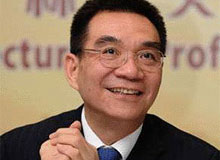Following the announcement of China’s leadership change this month, the world is wondering: Can the government of Xi Jinping keep the country’s economy going? According to Justin Yifu Lin, a former chief economist of the World Bank, China has the potential to keep growing at 8% for the next 20 years if policymakers continue with the right economic reforms.
China has been able to grow continuously at 9.9% for the past three decades by tapping into its “advantage of backwardness,” a strategy it should be able to continue for another two decades, said Lin, who served as chief economist and senior vice president for the World Bank from 2008 to 2012. He spoke at the University of Pennsylvania recently as part of a series of events sponsored by the school’s Center for the Study of Contemporary China.
“There’s no reason to think that China doesn’t have the potential to grow at 8% for another 20 years” if the right measures are taken, Lin noted. “I am optimistic about the potential, but whether the potential can be realized very much depends on the policy as well as the environment. And the government needs to be adept to [craft] the policy contingent on the opportunities and the challenges.”
The primary obstacles to China’s growth are not its rapidly aging population, the lack of a democratic system of government or ownership of state enterprises, according to Lin, who spent 15 years as founding director of the China Centre for Economic Research at Peking University before his tenure at the World Bank. The biggest challenges the government faces are “distortions” created by three decades of rapid economic growth using a “dual track approach,” he said. China must remove those distortions and further implement market-oriented reforms if it wants to continue its upward economic march.
China is one of thirteen economies since the end of World War II to achieve a growth rate of at least 7% for 25 years or more by tapping into the “advantage of backwardness,” Lin noted. Japan maintained an average growth rate of 9.2% for 20 years; Singapore averaged 8.6% for 20 years; Taiwan 8.3% for 20 years, and Korea 7.6% for 20 years. Like China after 1979, these countries tapped into this advantage by importing existing technologies and harnessing their labor to manufacture and export products that the rest of the world wanted.
“For a low-income country, the sectors where they have competitive advantages are labor-intensive sectors,” Lin pointed out. “So if you develop labor-intensive sectors, since it’s consistent with your comparative advantages, you will be very competitive [and] at the same time create a lot of jobs.”
A Dynamic Shift
Before 1979, China was not able to achieve dynamic growth because it was not tapping into this benefit. The government set ambitious Five-Year Plans to modernize heavy industries and catch up with the United Kingdom in 10 years and the United States in 15 years. But as a poor agrarian economy, it could neither obtain nor invent the technology needed and could not afford to compete in such capital-intensive sectors.
After 1979, however, China shifted its focus and adopted a gradual, dual-track approach that developed its labor-intensive industries while protecting and propping up firms in non-viable sectors. The gradual transition allowed China to grow rapidly without disrupting social stability by reforming markets too abruptly, Lin said. “If China did not use the dual-track approach, China might have immediately encountered 30% or 40% unemployment, and we know that is not good for the growth.”
But China paid a price for its dual-track reform: income disparity, over-saving, over-investment, insufficient consumption and a huge trade surplus. For 30 years, China’s economic policies favored some sectors at the expense of others, resulting in a number of distortions in the economy, Lin explained. For example, in order to fuel non-viable, capital-intensive sectors, the government created a financial system that provided financing to large state-owned firms at the expense of agrarian households and small and medium-sized enterprises. Although such groups account for 80% of China’s employment, they have had little access to financial services, and have struggled to develop. “If you suppress their development, you suppress the labor force,” Lin noted. “If you ask the poor people to subsidize the rich people’s growth, the income disparity is going to grow larger and larger.”
China now needs to work to remove such remaining distortions, which are no longer beneficial to its growth, Lin said. “After 32 years, state-owned sectors have been reduced from about 60% of GDP to about 25% of GDP,” he added. A lot of once-weak state-owned industries such as automobiles are now strong. “You don’t need to give them protection anymore,” Lin suggested. Policymakers “should introduce market competition to force them to further improve.”
A New Era of Change
Competition, not ownership, is vital to China’s continued economic growth, Lin noted. “Competition is more important than ownership reform,” said Lin of China’s state-owned industries. If China increases market competition, state-owned corporations will need to rise to the challenge and compete with the private sector. Whether the corporations are owned by the government or by shareholders, it is market competition that generates the information management needs, he added.
Lin did not point to democracy as a prerequisite to China’s continuing economic growth, noting that other countries in the past achieved dynamic growth without democratic systems. Japan, for example, had a one party system for 50 years. Korea and Taiwan both had dictatorships. Singapore has a one-party system. Besides, Lin added, “You have so many types of democracies…. Which type of democracy are you talking about?” France, Germany and Great Britain all have different forms of democracy, for example. “I’m sure China will move to a more democratic system by allowing more voices and more representation,” he said, but China will not have a system that is similar to France or German or Great Britain because China is different.
Constitutional reform is not a guarantee of economic growth either, Lin added. “India had a constitutional reform, but economic problems in India [come from] corruption and misallocation of resources,” he pointed out. “If you look at the former Soviet Union or Eastern European countries, they carried out those kinds of institutional reforms…. But if you look at the corruption in Russia, it can be even worse than in China.”
The concentration of power in China today is actually less than in 1979, when state-owned sectors took up a larger portion of the economy, and the rural areas were governed by the commune system. “Political leaders always have some degree of freedom for introducing changes,” he noted.
Lin also said that China’s rapidly-aging population “puts pressure” on the economy but wouldn’t likely create “a big hurdle” to future growth because China can address it in different ways. China’s retirement age right now is very low, so the government could extend it to overcome a shortfall in the nation’s labor supply, Lin suggested. China could also relax the one-child policy to mitigate the slowdown in population growth. The nation may also opt to invest in education to enhance its human capital, improving the quality of its labor and reducing the need for quantity.
“What really can be a challenge is something you cannot expect,” Lin said. “Then we have no way to cope…. But if it’s something that you can predict, you can always find positive responses. I don’t think aging is going to be a main barrier to growth in China.”
China’s continued growth is important not only for China but for the rest of the world, Lin noted. If China can keep growing, it will eventually upgrade to more capital-intensive industries, allowing labor-intensive sectors to move to other developing countries.
“We know that in the 1960s, when income started to increase in Japan, Japan started to relocate its labor-intensive sectors to Korea and Taiwan and helped them to start their industrialization process,” Lin said. In the 1980s, Korea, Taiwan and Singapore sent labor-intensive industries to China. Now China is getting ready to export its labor-intensive sectors elsewhere. The difference, Lin added, is that in the 1960s, Japan only employed 9.7 million workers in those labor-intensive sectors. In the 1980s, Korea employed 2.3 million, Taiwan less than 2 million, Hong Kong about 1 million and Singapore about a half million. “But this time, China employs 85 million workers in labor-intensive manufacturing sectors.”
Lin predicts that within 10 years, all of those workers will need to be relocated to another country. Everyone will gain from this kind of scenario, Lin suggested. India, which currently employs less than 10 million in its manufacturing sectors, might absorb some of the industries; countries in Africa might take some more. “It’s not only important for China,” he said. “It will be beneficial to the world as a whole…. Growth in China will be a win-win for everyone.”



